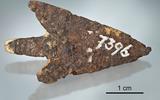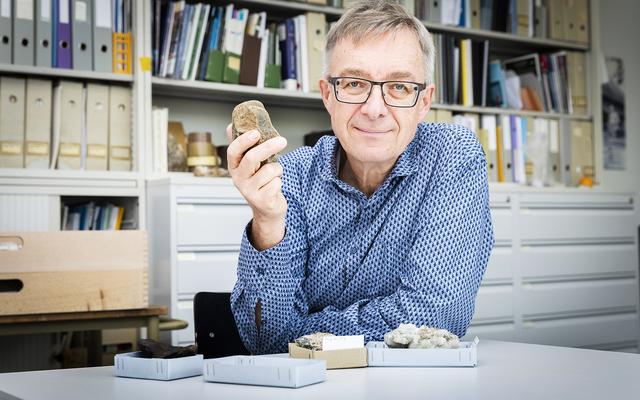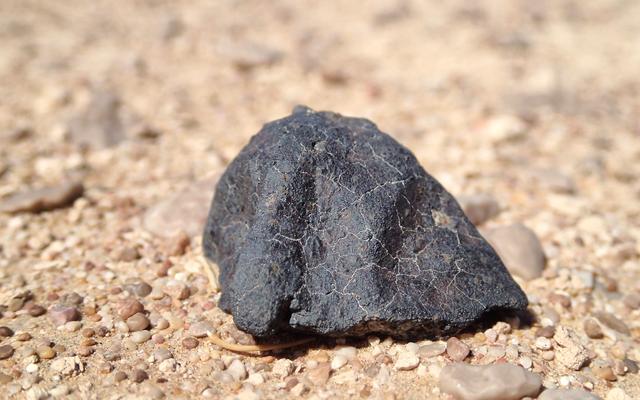In February 2021, a 39 mm long iron arrowhead weighing 2.9 grams has now been identified at the Bernese History Museum. It comes from a Bronze Age pile-dwelling site near Mörigen on Lake Biel (900–800 BC) and was found during excavations in the 19th century. The site is only a few kilometres away from the Twannberg meteorite strewn field. In order not to damage irreplaceable historical artefacts, non-destructive examination methods must be used for the analysis. A detailed examination of the arrowhead confirmed beyond doubt that it was made of meteoritic iron. The results have now been published by an interdisciplinary and international group of scientists in the “Journal of Archaeological Science”.
Iron is the most widely used metal today. The art of making iron from ore has been known in Central Europe since the beginning of the Iron Age around 800 BC. Before that time, the metal was considered extremely rare and precious — it was only known from meteorites. Archaeological objects made of meteoritic iron are extremely rare, however — only 55 such objects are known from the whole of Eurasia and Africa, and these come from 22 sites. Nineteen objects alone are from tomb of the pharaoh Tutankhamun in Egypt. However, only some of the artefacts have been examined with modern analytical methods.

New examination methods in use
The Natural History Museum Bern is researching the Twannberg meteorite strewn field in the Bernese Jura in Switzerland. Over 2000 fragments of an iron meteorite fallen approximately 170’000 years ago have been found here up to date. Parallel to this research, many archaeological objects from the region were analysed for high nickel content, typical of meteorites, using a portable analysis device (X-ray fluorescence, XRF) in order to clarify this question: Were pieces of the Twannberg meteorite possibly known and used a long time ago? And was the arrowhead of Mörigen made of it?
The methods used include light microscopy, scanning electron microscopy, X-ray tomography, X-ray fluorescence, muon-induced X-ray emission (MIXE) and highly sensitive gamma spectrometry. The latter two methods originate from nuclear and particle physics and were used for the first time to characterise an archaeological object made from a meteorite. MIXE allowed the chemical analysis of the metal under a millimetre-thick layer of rust. Gamma spectrometry was used to detect aluminium-26, proof that the meteorite had been exposed to cosmic radiation for a long time in space.

Surprising test result
These analyses clearly show that it is a piece of iron meteorite — but surprisingly not from the nearby Twannberg strewn-field! With about 8.3% nickel, the content of this element in the arrowhead is almost twice as high as in the Twannberg meteorite. A high content of germanium also shows that it is very likely a type IAB meteorite. Furthermore, it could be shown that the rather low concentration of aluminium-26 indicates that the sample originates from the interior of a meteorite which originally had a mass of at least 2 tons. There are only a few known large IAB iron meteorites in Europe. The most probable origin is assumed to be the meteorite “Kaalijarv”, which fell in Estonia during the Bronze Age (approx. 1500 BC). The fall of this meteorite produced several craters up to 100 m in diameter. Since the largest meteorite fragments exploded on the ground, many small splinters must have been produced.
Traces of grinding were found on the surface of the arrowhead, as well as remains of tar, which was probably used to attach it to an arrow. Due to the rarity of the material, however, it was probably not an object of every-day use.
The closest finds of archaeological objects made of meteoritic iron in Europe are known from Poland, but this is again clearly a different meteorite. Further analyses in archaeological collections in Europe could provide clues as to whether the trace of the arrowhead from Mörigen to Estonia can be confirmed.
From February 1, 2024 until April 21, 2025, the arrowhead will be on display at the Bernisches Historisches Museum as part of the special exhibition “And then came bronze!” — together with the Prêles bronze hand.
Involvement of the institutions:
- Natural History Museum Bern: Idea for study and coordination, co-discovery and XRF analytics (Prof. Beda Hofmann, project lead)
- Bernese History Museum: Co-discovery, owner of the arrowhead (curator Sabine Bolliger Schreyer)
- Paul-Scherrer-Institute: MIXE analytics (Dr. Alex Amato)
- Institute for Geological Sciences, University of Bern: X-ray tomography, scanning electron microscopy (Prof. Pierre Lanari)
- Physics Institute, Albert-Ludwigs-University Freiburg, Germany: Gamma-spectrometry (Prof. Marc Schumann)


